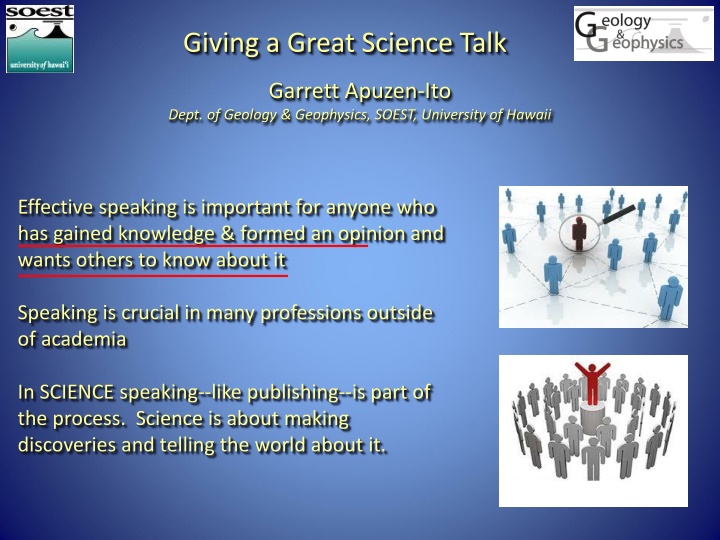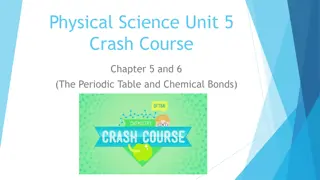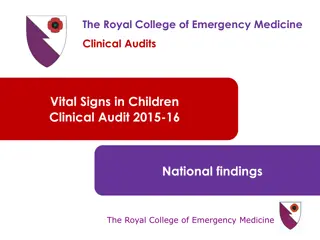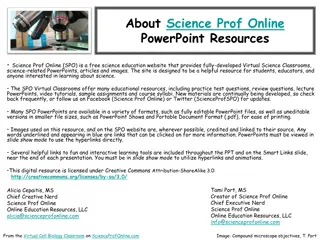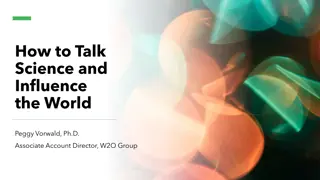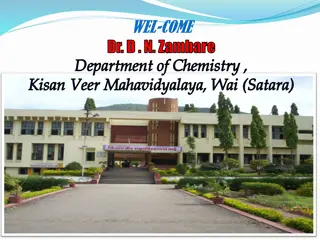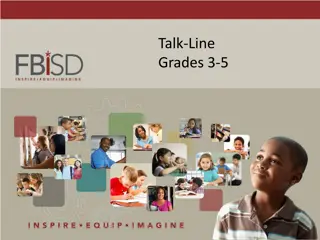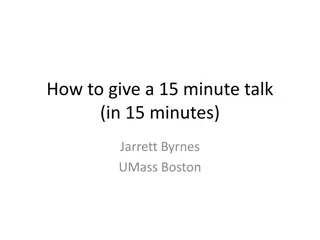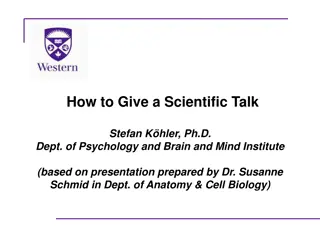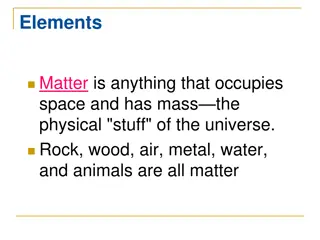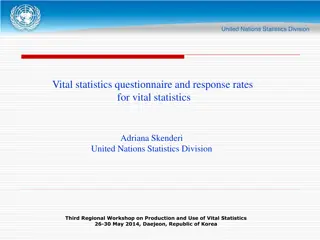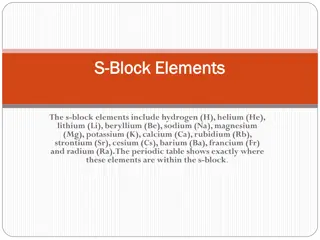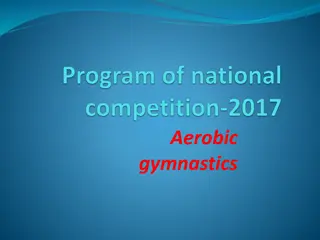Vital Elements of Science Talk
Effective speaking in science is crucial for communicating discoveries. Understand the vital elements including motivation, strategy, results, and conclusions to ensure your message is clear and impactful. Organize your talk logically by introducing the topic, defining key concepts, explaining new information, and highlighting main points for a successful presentation.
Download Presentation

Please find below an Image/Link to download the presentation.
The content on the website is provided AS IS for your information and personal use only. It may not be sold, licensed, or shared on other websites without obtaining consent from the author.If you encounter any issues during the download, it is possible that the publisher has removed the file from their server.
You are allowed to download the files provided on this website for personal or commercial use, subject to the condition that they are used lawfully. All files are the property of their respective owners.
The content on the website is provided AS IS for your information and personal use only. It may not be sold, licensed, or shared on other websites without obtaining consent from the author.
E N D
Presentation Transcript
Giving a Great Science Talk Garrett Apuzen-Ito Dept. of Geology & Geophysics, SOEST, University of Hawaii Effective speaking is important for anyone who has gained knowledge & formed an opinion and wants others to know about it Speaking is crucial in many professions outside of academia In SCIENCE speaking--like publishing--is part of the process. Science is about making discoveries and telling the world about it.
Giving a Great Science Talk I. Vital Elements II. Mechanics of the Presentation III. Speaker Performance
I. Vitals Elements FIRST AND FOREMOST: Your purpose is to Communicate, Convince, and Teach WMDs! If your audience walks away understanding your main points, gains new appreciation for (or is convinced of) them, and remembers them, then you ve done your job. points and no more. It is essential that YOU know your main points. You should have 1-3 main Now here s the main point No matter how you do it (almost).
Elements of a formal science talk: Tell em what your gonna tell em I. Motivate & Introduce the Scientific Questions, Problem, or Hypothesis, and Outline Your talk } II. Strategy, Methods &/or Data Tell them. } Tell em what you told em } III. Results and Interpretations IV. Conclusions
This format represents a system of logical reasoning. An underlying thread along which your story progresses. I. Motivate & Introduce Science Questions, Problem, or Hypothesis & Outline Talk II. Strategy/Methods/Data III. Results/Interpretations IV. Conclusions
More generally a science-related talk is organized as: Tell em what your gonna tell em } Tell em what you told em } } I. Motivate and Introduce the Topic/Goal II. Define Strategy and Concepts Tell them. III. Explain New Information, Ideas, Evidence IV. What You Learned (1-3 main points)
I. Motivate & Introduce the Goals, Question, Problem, Hypothesis & Outline your talk 1st Your audience needs to know WHY your talk is work listening to. Tides are important because 2nd Your audience needs to know the goals (question, problem, or hypothesis your addressing) 3rd Outline your talk. i.e., tell you re audience what your going to tell them. The problem I d like to address is
I. Motivate & Introduce the Goals, Question, Problem, Hypothesis & Outline your talk II. Strategy, Methods &/or Data The strategy had better be appropriate for addressing your goal/question/problem/hypothesis I will measure the level of high tide each day
I. Motivate & Introduce the Question, Problem, or Hypothesis, & Outline your talk II. Strategy, Methods, &/or Data III. New Information, Results , Interpretations New Info or Results. Graphs show trends of data. Objective outcomes of analyses are presented. Judgements made about the significance of the results Monday the tide covered the rock Tuesday it reached the tree Tomorrow . Uhm, can you swim?
I. Motivate & Introduce the Question, Problem, or Hypothesis, & Outline II. New Information, Strategy, &/or Data III. New Information, Results, Interpretations IV. What You Learned, Conclusions Recap and clearly state your 1-3 points. Got it??
Build a Theme by Re-emphasizing the Goals random bunch of (albeit jewels of) information I. Motivate & Introduce the Goals/Hypothesis/Question II. Strategy/Methods/Data Establish the thread that ties all the pieces together III. New Information/Results IV. What you ve learned/Conclusions
Tell a Story. Take your Audience on an Adventure Take your audience from the starting point (A), lead them forward step-by-step along your journey of discovery to your conclusions (point B) I. Motivate & Introduce the Goals/Hypothesis/Question B Tell em what you told em II. Strategy/Methods/Data III. New Information/Results Tell them. IV. What you ve learned/Conclusions Tell em what your gonna tell em A
Giving a Great Science Talk I. Vital Elements II. Mechanics of the Presentation III. Speaker Performance
First Lets Cover II. Presentation Mechanics
II. Presentation Mechanics: TIMING 12-minute research (i.e., for final projects) talk (about 1 minute per slide) I. Motivate & Introduce the Goals/Hypothesis/Question (1-2 minutes) A (3-5 minutes) B II. Strategy/Methods/Data (3-5 minutes) III. New Information/Results B IV. What you ve learned/Conclusions (1-2 minutes) A
Image Content: How much content is appropriate for a single slide, considering that this is the 1st time your audience has see it?
Image Content: How much content is appropriate for a single slide, considering that this is the 1st time your audience has seen it?
Image Content: How much content is appropriate for a single slide, considering that this is the 1st time your audience has seen it? Enough to get 1-2 points across
BUT if you want to show a lot of information for comparison..
Oh, and about showing PLOTS Remember you are asking your audience to absorb the plot in ~1 minute. Take the time to describe each axis of the plot and point out the key trends that they are supposed to catch
Tell a Story. Take your Audience on an Adventure B so that successively, the talk progresses steadily along the story line and move them forward should take the audience from where you left them in the previous slide Each slide A
Image Layout: Balance the size of text and images
Is this better? 30 20 3He/4He 10 0 0.7060 87Sr/86Sr 0.7050 0.7040 0.7030 0.7020 0 2 4 6 8 10 12 Square-Root Seafloor Age (m.y.1/2)
Is this better? 30 3He/4He 20 10 0 0.7060 0.7050 87Sr/86Sr 0.7040 0.7030 0.7020 0 2 4 6 8 10 12 Square-Root Seafloor Age (m.y.1/2)
How much text is appropriate for each slide?
About as much as they can read in ~1 minute. AND it helps to support text with images.
Use colors to distinguish, emphasize, clarify, & add a bit of life
IF they are used APPROPRIATELY! Keep em tasteful and professional
What about Powerpoint Animations and Tricks? Use them to add a bit of variety, illustrate a point, &/or for emphasis. For example .. But its better to error on the conservative so as not to cause a DISTRACTION
Giving a Great Science Talk I. Vital Elements II. Mechanics of the Presentation III. Speaker Performance
Speaker Performance Movement Voice Use deliberate hand gestures PROJECT Moving around to reach out to audience Vary pitch, vary speed Punctuate with pauses (avoid monotone) Minimize nervous tics Attitude Occasional Humor Helps Be natural Be enthusiastic Smile
Pointing specifies & focuses attention Systematic Fault Patterns on Earth
Speak accurately. 12 minutes is not time for meaningless words/non-words Uhhh Like Uhmm Ya-know
Remember: Describe the axes and point out key features. You MUST budget time for this. 30 3He/4He 20 10 0 0.7060 0.7050 87Sr/86Sr 0.7040 0.7030 0.7020 0 2 4 6 8 10 12 Square-Root Seafloor Age (m.y.1/2)
Answering Questions Repeat or summarize the question; if needed (paraphrase it to your advantage) Answer simple factual questions simply & factually Answer the question being asked Never bluff. If you don t know the answer, say so strategically. I ll have to give that some more thought . Good question, I hadn t thought of it in that way before. Lets discuss this further.
LAST BUT NOT LEAST PRACTICE 1 PRACTICE 2 PRACTICE 3
Giving a Great Science Talk B Tell em what you told em Tell them. Tell em what your gonna tell em A
